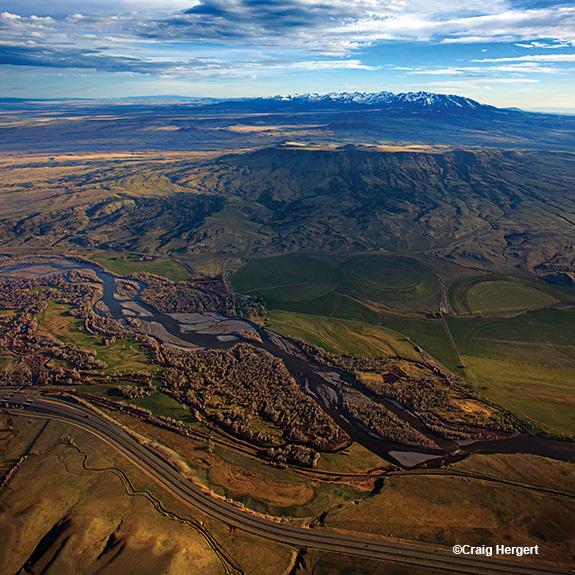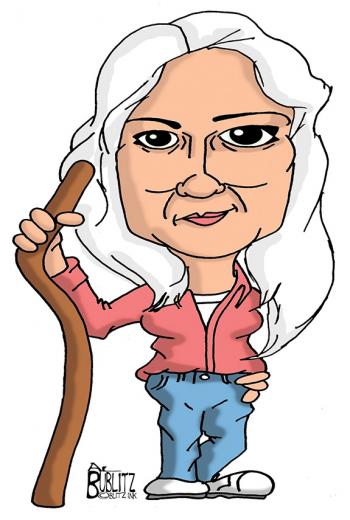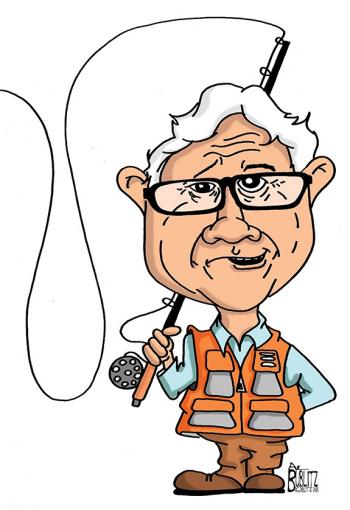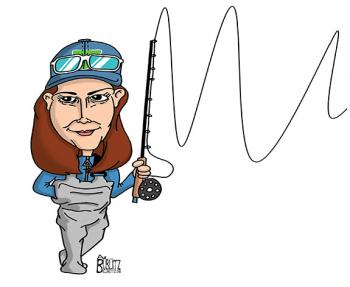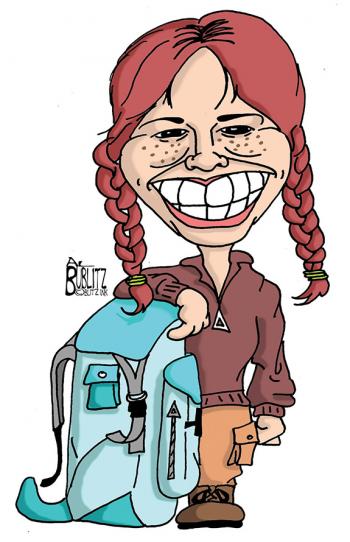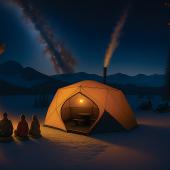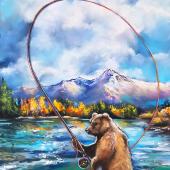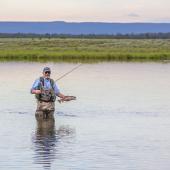By the People, For the People
Local warriors in the fight for public land.
It seems that each season brings yet another attack on access to public land and water. All around southwest Montana—like the rest of the West—signs are going up, gates are being locked, roads and trails are being blocked off. Meanwhile, the public is fighting back, mainly by supporting area nonprofits with the means and manpower to resist big money and the government officials representing it. Behind this battle to protect our public access are a slew of individual crusaders who are making a difference in a variety of ways, big and small, local and national. Here’s a look at a few access advocates you’re more likely to run into on the trail than see on TV.
The Journalist
Although Kathryn QannaYahu and I had worked on public-land and wildlife issues for years, I’d never had an opportunity to get to know her personally until this past summer, when my wife Lori and I visited her Bozeman home. For several hours, Lori and I sat back and let the force of her intellect and enthusiasm break over us like waves on a beach.
A tall, striking woman with piercing green eyes and a long shock of unruly white hair, Kat, as she is known to friends, was born in Texas and traveled a remarkable swath of the country before settling in Montana ten years ago. Dominated by the glow from a hyperactive computer screen, her small Bozeman apartment offers a testimonial to her enthusiasm for researching the causes she cares about. Boxes of files and documents fill the room. A dry-erase board covers one wall, full of notes and flowcharts reminiscent of a scene from a cop drama investigation. Her home seems more a working space than a living space.
A question about her unusual name, which she adopted after a divorce, leads to a dissertation on ancient languages, an arcane field in which she is largely self-taught. Qanna, she explained, is an ancient Ugartic term for zealot, a term of admiration her father has used to describe her all her life. Yahu derives from a Sumerian term for a female protectoress, a pre-Grecian Artemis. Both components of her name fit perfectly.
In 2013, Kat used her communications skills to begin work on a blog and website that eventually launched as EMWH—Enhancing Montana’s Wildlife and Habitat. The site now has subscribers in over 30 states, many of whom work on behalf of local conservation and land-access advocacy groups driven largely, but not exclusively, by hunters and anglers. The West is particularly well represented.
A highly proficient online researcher, Kat fires off Freedom of Information Act requests faster (and more accurately) than I fire arrows at targets. She was the first journalist to make the public aware of Greg Gianforte’s lawsuit against the state over public access on the Gallatin River, long before Montana’s lone Congressman gained fame for body-slamming reporters.
One of her most significant accomplishments involves the key role she played in helping Montana sportsmen’s groups successfully battle the billionaire Wilks brothers over the Texans’ attempts to acquire public land in the Durfee Hills, which their Fergus County ranch surrounds. When their naïve request to purchase the land failed (you can’t do that) and subsequent land-swap proposals went down the drain, they fenced off the public section of the Durfees—illegally, as it turns out. Kat and local access advocates flew in, photographed the fencing, documented the damage done constructing it, took GPS readings, and proved that the brothers had placed fences on land they didn’t own. Under pressure from Kat and her associates, the BLM eventually required the Wilks brothers to move the fencing, bring it up to proper standards, and pay restitution for the damage. The Durfee Hills remain public, though access is difficult.
Now Kat is busy documenting closure of public trails in the Crazy Mountains by local landowners, as well as supporting ranger Alex Sienkiewicz, who was reassigned under pressure from Washington for defending public access in the Crazies. EMWH has also become a repository for countless records that may become crucial in access issues yet to come. It’s demanding, full-time work, and Kat subsists on the modest (to say the least) income EMWH subscribers provide. To stay abreast of current developments regarding these crucial issues and help sustain this invaluable resource, contact emwh.org. —E. DONNALL THOMAS, JR.
The Lawyer
If you’ve ever parked your car beside a public bridge and descended to the river, to spend a blissful day fishing or just strolling the streambed below the high-water mark, then you need to know this name: Jim Goetz. Goetz, a native Montanan, grew up fishing and floating the Treasure State’s many miles of blue-ribbon rivers and streams and has devoted a sizable part of his legal career to making sure that others will be able to do the same for generations to come.
For decades, his Bozeman law firm—Goetz, Baldwin & Geddes—has worked to preserve and expand access to both public waters and public lands. Most notably, Goetz was the leading attorney in helping to establish Montana’s celebrated Stream Access Law in 1985. Devlan Geddes, of Jim’s firm, recently defended the law in the face of the legal challenges brought about by a group of wealthy out-of-state landowners along the Ruby
River near Twin Bridges who were determined to see the law reversed. Geddes prevailed in the face of this well-funded challenge, and now the benefits that the Montana Stream Access Law provide to anglers and other recreationalists are on solid ground. In fact, Goetz is quick to point out that all waters which have a public means of access are open to anglers and other recreationists—not just those that are “navigable.” That means lakes and reservoirs, too. “We’re very lucky as Montanans to have access to the water and land that we do, and this is thanks to the farsighted decisions of the Montana Supreme Court,” Goetz says. “We’re blessed here compared to other western states like Colorado and Wyoming.” He explains that the basis for the Stream Access Law is the Montana Public Trust Doctrine, a cornerstone of the state’s constitution, which declares that all waters are held in public trust for the benefit of the state and its people.
Even with his successes, however, Goetz reminds us that our rights to public lands and waters are never without threats. “It’s good to be vigilant,” he says, imploring us all to think and act broadly when it concerns public access to Montana’s rivers and streams. A conversation with Goetz made it clear that, politically speaking, it all matters, from your county commissioner to who’s on the United States Supreme Court. Goetz encourages all stakeholders to get involved, and he referenced the Montana-based Public Land/Water Access Association (PLWA) as an effective place to start (plwa.org).
According to Goetz, landowners often cite people’s lack of stewardship toward their own public lands as a reason for denying access to private property. Goetz touched on the fact that “there’s always some joker out there who abuses the public right; we have to be careful to monitor our own use and behave appropriately.” A good point, albeit clearly not obvious to everyone.
People disrespecting the land and access to which we all have a right is an understandable complaint, but it is also a problem all users can work together to solve by means of self-policing, clean-up days, and education. Overall, Goetz says that the use of water and land by the general public is without issues and has always been so. The threat to access, he says, has come largely from wealthy newcomers to the state who have no respect for Montana’s tradition of public access to public lands.
Finally, Goetz advises civility on the part of an angler in the face of an angry and belligerent landowner. “The situation is always explosive, and the 2nd Amendment is big in Montana,” he says. In other words, don’t get yourself shot in an access argument. Instead, as Atticus Finch once advised in Harper Lee’s famous novel, To Kill a Mockingbird, “try fighting with your head for change”—an admonition that Goetz himself followed in 1985 and still heeds to this day. —JIMMY LEWIS
The Angler
In the high-water year of 2011, the Yellowstoneran bigger than normal well into September. While floating near the Sheep Mountain Fishing Access Site downstream of Livingston, guide Sarah Clark came upon a startling scene: two men on an island, soaked through, one doubled over at the water’s edge vomiting. Their boat was nowhere to be seen. Digging hard against the current, Clark made for the island and called to the men, who turned out to be father and son. Clark loaded the men and their dog into her boat and rowed them to safety. “Their own boat is probably still at the bottom of the river,” Clark says, as she remembers the chaotic scene. “They’re really lucky they didn’t drown."
Just another day in the life of a southwest Montana fly-fishing guide and instructor. “Whether it’s running out of gas with a client, or saving people on the river, every day is an adventure,” says Clark. And that adventure has only gotten more unpredictable as more people descend on the rivers of southwest Montana. Originally working in community health, Clark always harbored a love of fishing, and in 2008 she made the jump to guiding and instructing. “I made the decision I was going to dive in head-first,” she says.
This commitment and passion soon led to advocating and volunteering, as well. “As I learned more about fishing and our rivers, I had those ‘wait-a-minute’ moments,” she explains. “There are a lot more people and anglers on the water these days—how is this all going to work out?” Her concern led Clark to the board of Madison-Gallatin Trout Unlimited, where she helps promote local conservation efforts. Clark sees the population in the valley growing and knows that is it up to passionate anglers like her to step up and educate people. “We need more guides at the conservation table,” she says. “98% of fly fishers care about the health of rivers and want to do it right. Tourists aren’t resistant, either; they just don't know the issues. Guiding is a great opportunity to talk about our resources and build support for local conservation efforts and access issues.”
And Clark finds that the best place to educate an otherwise uninformed tourist is on the very waters she’s guided. “We talk about access and it’s a priority to discuss conservation,” she says. “It's not a forced conversation—it's usually pretty natural throughout the day.”
Clark’s time on the water has dwindled as she’s devoted more time to advocacy and education. And while her fly-fishing accomplishments would make any angler envious, she’s proudest of her classroom work, much of it with women. “I want to be an available resource for other women,” she says, and to that end she hosts the annual Chica de Mayo event at the River’s Edge fly shop. This past May, over 200 ladies showed up. “It now includes more time for education and more keynote speakers with a conservation angle," Clark explains. “I want people to know these issues, and with female participation booming, we’re educating future stewards.”
In Montana, it’s impossible to advocate for rivers without advocating for access. “At Trout Unlimited, we’re always monitoring the stream-access law,” says Clark, “and I do worry about an out-of-state agenda—Montanans decided a long time ago that we want stream access, and I don’t want to see that change.” —DAVID TUCKER
The Advocate
“I wanted to find ways to reach my people.” That’s how Bozemanite Hilary Eisen describes her path to advocacy. Her people are you and me: climbers, skiers, runners, hikers, paddlers—the entire menagerie of human-powered outdoor recreationists. “In Bozeman,” she says, “I somehow found the perfect blend of what I like to do for work and what I like to do for fun.”
Eisen has her fingers on the pulse of the Bozeman outdoor community; she’s the recreation planning and policy manager for the Winter Wildlands Alliance (a national nonprofit dedicated to preserving wild land and human-powered snowsports recreation on public lands); a leader in the national Outdoor Alliance; and a board member for Friends of Hyalite and guide for the Bozeman Ice Fest. Even after all that, she’s still a familiar face at the crag, in the skintrack, or tramping through the wilds of Yellowstone.
What she likes to do for work is complicated. She wades through the ever-shifting quagmire of federal public-lands policy, finds ways to educate and engage “her people” on issues that affect them, and stands as a liaison, interpreter, and cheerleader to encourage productive conversation and policy action. The outcome, she hopes, is that public lands remain public, and wild lands remain wild. If she gets to spend a lot of time in the backcountry in the process, all the better.
By comparison, what she likes to do for fun is simple: climb, hike, ski, and enjoy quiet, wild places. “I didn’t want to work for a traditional conservation group,” she explains. “I needed to combine conservation and recreation.” And with just a bit of serendipity, she’s found a way to do just that, right here in Bozeman.
Eisen grew up in Billings, studied biology and environmental studies at Middlebury College in Vermont, and then moved to Cody, Wyoming to climb ice and work for the Greater Yellowstone Coalition, her first foray into conservation policy. “Ice climbing is kind of my thing,” she says. “I moved to Cody for the ice, and I moved here for the ice.” But after her stint in Wyoming, she enrolled at the University of Montana and earned a Master’s in wildlife biology.
She found her job at Winter Wildlands Alliance through sheer providence: she attended the Backcountry Film Festival, a touring film fest sponsored by the Alliance. “I’d never heard of WWA before that,” she says. Shortly thereafter, she saw a classified ad describing her ideal position; it was for WWA, and she was a perfect fit.
“In terms of public policy and working with the federal land-management agencies, Hilary is one of the smartest, most effective advocates I’ve ever met,” says Mark Menlove, executive director of WWA. “The fact that Hilary is a legitimate badass when it comes to climbing and skiing, combined with her depth and breadth of knowledge on the policy front, gives her unique credibility in both camps.”
Eisen’s focus at the moment is engaging policy makers and the public to fight privatization of public lands. Bills that directly promote federal land transfers have proven controversial and ineffective, so some conservative lawmakers have adopted a more deceptive strategy, according to Eisen. “What we’re seeing now are efforts to disinvest the public [from public lands].”
Those efforts include defunding federal land-management agencies (rendering them ineffective) in order to encourage privatization; creating a timber sale and management “wish-list” under the guise of wildland firefighting; issuance of unprecedented executive orders (often followed by Sec. Zinke’s own secretarial orders) openly prioritizing energy development over all other federal land use; and promoting only “profitable” recreation such as private RV campgrounds. The idea is that if lawmakers can break the system enough, there will be no choice but to consolidate, sell, and privatize public lands.
Locally, Eisen and WWA are involved in the Custer-Gallatin National Forest Plan Revision, which involves working with supporters and other advocates to ensure appropriate and fair shared-use and access. And since Friends of Hyalite works as a partnership organization with the forest, she’s able to appreciate the forest from a variety of perspectives. “It’s nice to have the stewardship relationship as well as the advocacy relationship,” she says.
Eisen has passion, credibility, experience, and plenty of motivation. What she—and the American public—doesn’t have, is a lot of time. Even though outdoor recreation is an $887-billion-dollar-per-year industry, it doesn’t have the lobbying clout or strategic organization of big energy or corporate interests. That’s the ultimate battle for Eisen and the organizations she supports, she says: “Outdoor recreation just wants a seat at the table.” —DREW POGGE



